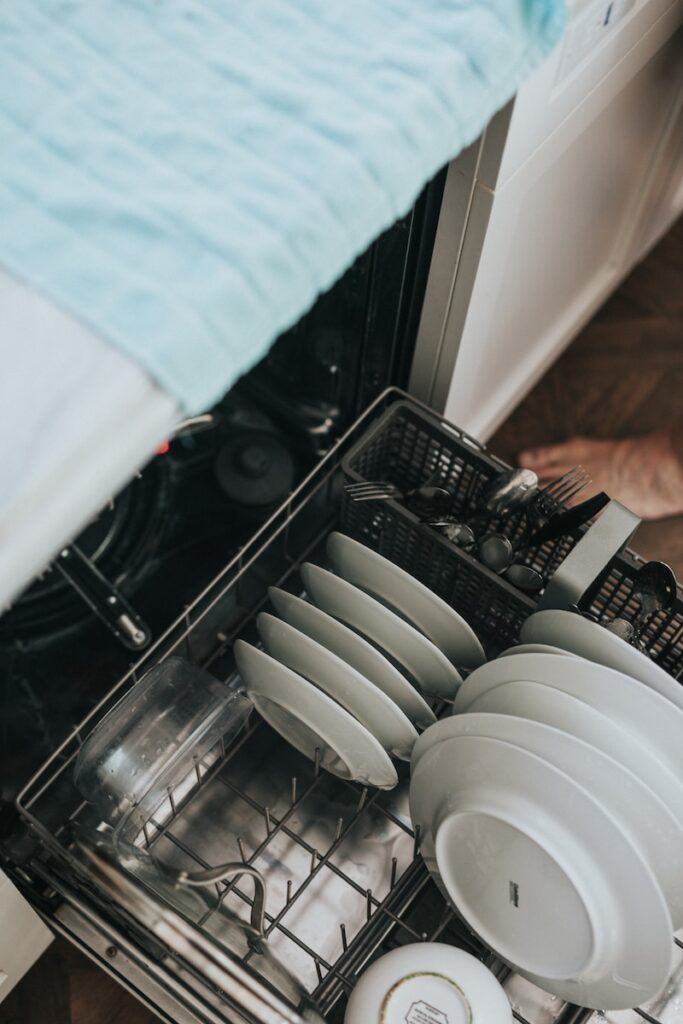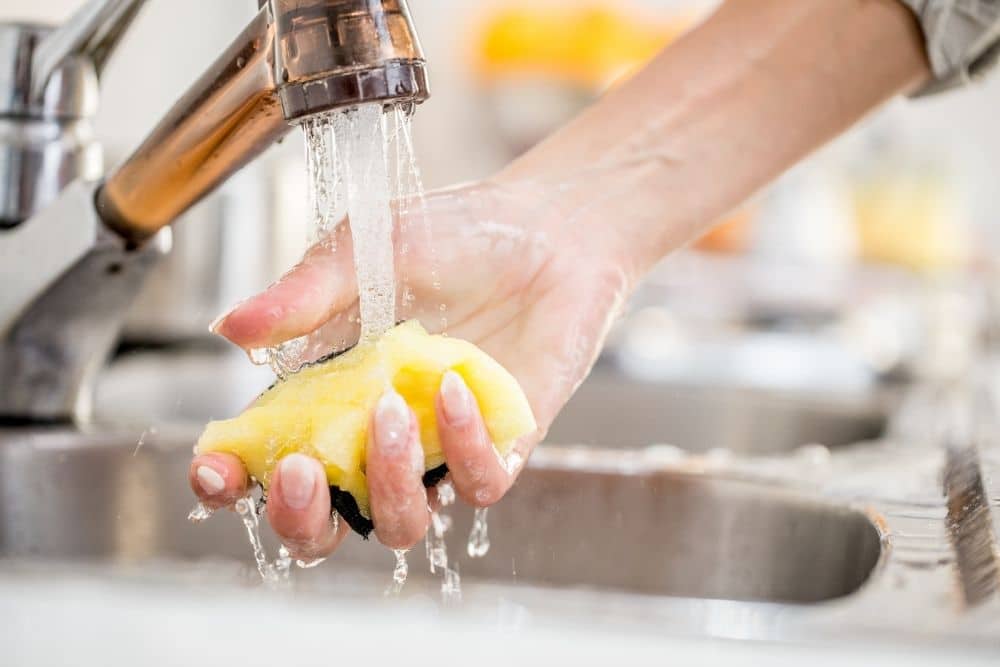How to Clean Your Dishwasher With Homemade Solutions? Cleaning your dishwasher is important to ensure it functions properly and doesn’t develop unpleasant odors. Deep cleaning your dishwasher on a semi-annual basis, as well as following good maintenance practices, will ensure it remains in good working condition and continues to provide clean, odor-free dishes. Here’s a step-by-step guide on how to clean your dishwasher:
Materials you’ll need:
- White vinegar
- Baking soda
- A toothbrush or small brush
- A soft cloth or sponge
- Dish soap
- A small bowl
- A dishwasher-safe cup or container

Step 1: Empty the dishwasher:
Remove all dishes, racks, and utensil holders from your dishwasher.
Step 2: Remove debris:
Use a toothbrush or a small brush to clean out any visible debris, food particles, or debris from the dishwasher’s filter, spray arms, and gasket. Ensure these areas are free from any blockages.
Step 3: Wipe down the interior:
Use a soft cloth or sponge dampened with warm, soapy water to wipe down the interior of the dishwasher. Pay special attention to the door gasket and the edges, as these areas can accumulate dirt and grime. Be gentle to avoid damaging any components.
Step 4: Clean the spray arms:
Remove the spray arms (if possible) and rinse them under warm, soapy water to remove any clogs. Reinstall them after cleaning.
Step 5: Run a vinegar cycle:
Place a dishwasher-safe cup or container filled with white vinegar on the top rack of the empty dishwasher. Then, run a complete cycle on the hottest water setting. The vinegar helps dissolve mineral deposits and eliminates odors.
Step 6: Baking soda scrub:
After the vinegar cycle, sprinkle a cup of baking soda on the bottom of the dishwasher. Run a short, hot water cycle to distribute the baking soda and leave it to sit for a few hours or overnight. Baking soda helps to remove odors and loosen any remaining residue.
Step 7: Final rinse:
Once the baking soda has had time to sit, run another hot water cycle to rinse away the baking soda and any remaining residue.
Step 8: Clean the exterior:
Wipe down the exterior of the dishwasher with a damp cloth and mild soapy water to remove any fingerprints or stains.
Step 9: Clean the filter:
If your dishwasher has a filter, be sure to clean or replace it according to the manufacturer’s instructions.
Step 10: Maintenance:
To prevent future buildup, regularly scrape dishes before loading them into the dishwasher and periodically run a vinegar or citric acid cleaning cycle.
Remember to consult your dishwasher’s manual for specific cleaning recommendations and to ensure you’re not using any materials that could harm the machine. Regular maintenance will help keep your dishwasher running efficiently and odor-free.
Dishwasher Cleaning Eco friendly Solutions:
You can clean your dishwasher using eco-friendly solutions to minimize the use of harsh chemicals. Here are some eco-friendly methods for cleaning your dishwasher:
1. White Vinegar:
White vinegar is a versatile and eco-friendly cleaner. You can use it to clean and deodorize your dishwasher.
- Place a dishwasher-safe cup or container filled with white vinegar on the top rack.
- Run a hot water cycle to distribute the vinegar and clean the interior.
- This helps dissolve mineral deposits and eliminates odors.
2. Baking Soda:
Baking soda is another eco-friendly cleaning agent that can help with odor and residue removal.
- Sprinkle a cup of baking soda on the bottom of the dishwasher.
- Run a short, hot water cycle to distribute the baking soda and let it sit for a few hours or overnight.
- Baking soda will help remove odors and loosen remaining residue.
3. Lemon Juice:
Lemon juice has natural antibacterial and antiseptic properties and leaves a fresh citrus scent.
- Place a dishwasher-safe container with lemon juice (freshly squeezed or bottled) on the top rack.
- Run a hot water cycle to distribute the lemon juice.
- This not only cleans but also leaves a pleasant fragrance.
4. Citric Acid:
Citric acid is an effective, eco-friendly cleaner for removing mineral deposits.
- Dissolve a few tablespoons of citric acid in a cup of water.
- Pour the solution into the detergent dispenser or a dishwasher-safe container on the top rack.
- Run a hot water cycle to clean the dishwasher.
5. Eco-Friendly Dishwasher Cleaning Tablets:
Some eco-friendly dishwasher cleaning tablets are available in stores or online. These tablets often contain natural ingredients and are biodegradable.
- Follow the instructions on the packaging for usage.
6. Regular Maintenance:
Preventive maintenance is essential for eco-friendly cleaning. To reduce the need for deep cleaning, consider the following:
- Scrape food particles off dishes before placing them in the dishwasher.
- Use eco-friendly dishwasher detergents that are phosphate-free and biodegradable.
- Run your dishwasher with full loads to conserve water and energy.
- Clean or replace the dishwasher filter regularly.
By using these eco-friendly solutions and practicing preventive maintenance, you can keep your dishwasher clean while minimizing your environmental impact. Additionally, consult your dishwasher’s manual for any specific eco-friendly cleaning recommendations from the manufacturer.

Is Deep Cleaning Your Dishwasher Necessary?
Deep cleaning your dishwasher is not something that needs to be done frequently, but it is important for the long-term performance, efficiency, and hygiene of your appliance. How often you should perform a deep clean depends on your usage and water quality, but a good rule of thumb is to do it every 3-6 months. Here’s why deep cleaning is necessary:
- Preventing Odors: Dishwashers can develop unpleasant odors over time due to food particles, grease, and grime that accumulate. A deep clean helps eliminate these odors.
- Maintaining Performance: A dirty dishwasher may not clean dishes as effectively as a clean one. Mineral deposits, debris, and clogs can reduce the efficiency of spray arms and filters.
- Hygiene: Food particles and residues in the dishwasher can harbor bacteria and mold, which can potentially transfer to your dishes and affect your family’s health.
- Preventing Clogs: Accumulated debris can clog the drain, causing water to back up in the dishwasher and potentially damage its components.
- Minimizing Mineral Buildup: In areas with hard water, minerals like calcium and magnesium can deposit on the dishwasher’s interior. Regular deep cleaning helps prevent these deposits from building up.
While deep cleaning is important, you can maintain your dishwasher and reduce the need for frequent deep cleaning by following some basic maintenance practices:
- Scrape and rinse dishes before placing them in the dishwasher to minimize food particles.
- Use a high-quality dishwasher detergent to effectively break down and remove food residues.
- Regularly clean the dishwasher filter and check the drain for clogs.
- Use rinse aids to improve the drying and cleaning performance.
- Run the dishwasher with full loads to maximize water and energy efficiency.
- Allow the dishwasher to air out by leaving the door ajar after a cycle.
Maintaining A Dishwasher:
Maintaining your dishwasher is essential for its efficiency, longevity, and hygiene. To ensure your appliance functions at its best, follow some key maintenance practices. Begin by scraping and rinsing off food residues from dishes before loading them into the dishwasher to prevent clogs and minimize the accumulation of debris. Use a high-quality dishwasher detergent that effectively breaks down food particles and aids in cleaning. Regularly clean the dishwasher’s filter and inspect the drain for any obstructions.
The use of rinse aids enhances the drying and cleaning performance, resulting in sparkling dishes. Additionally, consider running the dishwasher with full loads to maximize water and energy efficiency. To prevent odors and mold growth, allow your dishwasher to air out by leaving the door slightly ajar after a cycle. By incorporating these maintenance habits into your routine, you can ensure your dishwasher remains a reliable and hygienic appliance in your kitchen.
